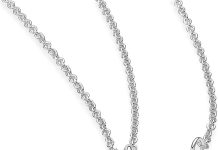For those of you born in June, pearls are your birthstone. A pearl is a gemstone, but unlike others, it is formed within a living creature – certain species of oysters and mussels.
Natural pearls are formed when sand or fishbone enters the body of an oyster. This causes irritation inside its body and to get rid of this irritation the oyster secretes layers and layers of nacre over the irritant which over a period of time forms into a pearl.
Pearls have always been a symbol of elegance, timelessness and are one of the top jewelry trends to watch out for in 2020. If you’re a novice to this lustrous yet fragile gemstone, read on for a guide to everything you need to know about pearls.
Review contents
Types of Pearls
Pearls are broadly classified as natural and cultured pearls. Natural or wild pearls are found by chance by shellfish harvesters. There is no human intervention involved. However, finding a pearl through this process is an extreme rarity, due to which they are sold at a higher price point. Natural pearls may also be smaller in size when compared to cultured pearls.
Cultured pearls are produced in a pearl farm with human intervention. Here, an irritant is inserted into the mollusks’ shell. A majority of pearls found in marketplaces today are cultured, and most of them come from China, Japan, Indonesia, the Philippines and Australia. Cultured pearls are further divided into:
Akoya Pearls – Often referred to as “classic pearls”, Akoya pearls have grown off the Japanese coast for the past 100 years. When you imagine the classic strand of round white pearls, you’re thinking of Akoya pearls as they are known for their perfectly round shape and reflective luster.

Akoya Pearls
Freshwater Pearls – These are the most affordable pearls and are the perfect choice for fashion-conscious women. They are famous for their baroque shapes and a wide range of pastel colours. They also have a softer lustre than Akoya pearls.

Freshwater Pearls
Tahitian Pearls – These pearls are often referred to as “dark and exotic”. They are naturally occurring black pearls but can also be found in green, blue and grey. They’re typically found in French Polynesia. Round Tahitian pearls are quite rare and are most commonly seen as drops and ovals.

Tahitian Pearls
South Sea Pearls – These pearls are known as the Rolls-Royce of Pearls as they are the largest seawater pearls grown today. They are found in Indonesia, Philippines and Australia with colors ranging from white to gold. Their enormity in size makes them quite rare, but perfect for a statement necklace.

South Sea Pearls
How to Distinguish Between Real and Fake Pearls
Real pearls display a natural beauty and hold a lot of value. Fake pearls, on the other hand, are priced at a lower cost. Also called faux, costume or imitation pearls, they are made of plastic, glass or fish-scale imitation. Here are some easy ways to distinguish real pearls from fake ones:
- When viewed under a magnifying glass, you will be able to spot surface ridges similar to sand dunes on real pearls. Counterfeit pearls will either look smooth or have bubbles.
- Real pearls will have an enriched body colour with overtones of other shades. Fake pearls will look white and flat.
- Real pearls are cold to the touch. You won’t feel the same coldness while handling fake pearls.
- If you were to rub real pearls across your teeth, they will feel gritty, while fake ones would feel smooth.
- Real pearls will appear smooth round holes drilled into them. Fake pearls will show bumps or some roughness.
What to Look for While Buying Pearl Jewellery
Buying jewellery is not something people do very often. If you’ re someone who only likes to own a few pieces, it will do you well to keep a few points in mind while buying jewellery. The same applies to your pearls. Pearl jewellery differs slightly from other gemstones since they are formed inside a living organism. This plays an important role while buying pearl jewellery.
- Natural pearls are extremely rare and hence several times more expensive than cultured pearls. Educate yourself on the different types of pearls.
- The number of layers of nacre and their thickness determine the quality of a pearl. Therefore, a pearl’s lustre influences its value.
- Pearls are graded according to the smoothness of their surface. Blemish-free pearls come at a premium price point; small spots don’t decrease their value as much as chips or cracks.
- A pearl’s price will increase exponentially with its size.













































